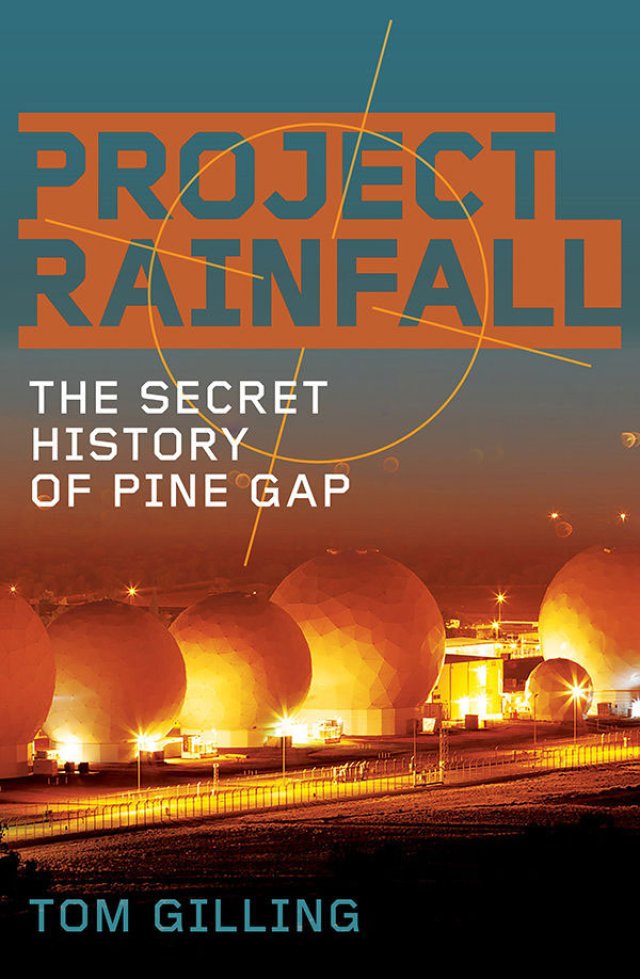
Project Rainfall: The Secret History of Pine Gap
Tom Gilling
Allen & Unwin, Sydney, 2019
306 pages.
On December 9, 1966, the Australian government signed a public agreement with the United States government to build what both countries misleadingly called a “Joint Defence Space Research Facility” at Pine Gap, just outside Alice Springs.
Officially, Pine Gap is a collaboration between the Australian Department of Defence and the Pentagon’s Defense Advanced Research Projects Agency. In reality this conceals the real purpose of Pine Gap as a CIA-run spy base designed to collect signals from US surveillance satellites in geosynchronous orbit over the equator.
Acclaimed author Tom Gilling has drawn on declassified documents from Australian and US archives to tell the secret history of Pine Gap, busting through the secrecy.
Starting in the 1960s at the height of the Cold War, Pine Gap was used by the US to spy on the Soviet missile tests, although it is most likely the Soviets knew about Pine Gap. Most of what goes on at Pine Gap is kept from the Australian government. Even former prime ministers such as John Gorton and Gough Whitlam were not fully aware of its operations.
For most of its history, Australians were only hired as cooks and janitors. All spies working there were from the US. While the Australian government denied that it made Australia a target for a nuclear strike, Gilling exposes how Canberra bureaucrats secretly planned for Armageddon. A 1980 Fraser government top secret report concluded that while unlikely, in the case of a nuclear war Pine Gap did make Australia a nuclear target.
Since the collapse of the former Soviet Union in 1991, Pine Gap has expanded. It has played a key role in both US wars on Iraq and the Pentagon's “war on terror”, as well as a means to listen in on people's phone conversations and spy on other counties in the Asia-Pacific region, such as Indonesia and China. The role of Pine Gap in the “War on Terror” was exposed by US whistle-blower Edward Snowden, who hacked into National Security Agency (NSA) files and went into exile to avoid the threat of a long jail sentence.
In the past, Pine Gap was a subject of intense political debate, with Whitlam making noises about closing the base.
Today, however, Pine Gap has bipartisan support. In February this year, then-defence minister Christopher Pyne told the House of Representatives that “Pine Gap represents the finest examples of collaboration, innovation and integration, and has delivered remarkable intelligence dividends to both our nations”. The ALP responded that it supported everything Pyne said.
However, there has been intense opposition to Pine Gap since the late 1960s. It was opposed by anti-war activists and late Australian National University academic Des Ball provided vital research for Project Rainfall. Since the 1980s, anti-nuclear and peace activists have frequently protested against Pine Gap and in 2005 four peace activists from a group called Christians Against All Terrorism protesting Australia's role in the Iraq war broke into the base. Clad in white overalls with insignia describing themselves as a "Citizen Inspection Team", they used bolt cutters to cut through both the outer and inner perimeters.
The Pine Gap Four were arrested and charged with intentionally causing damage to property and having breached two clauses of the Defence (Special Undertakings) Act 1952, which had never been used before. Eventually, the Northern Territory quashed all convictions under the 1952 Act, which meant that the Pine Gap Four were only guilty of property damage.
In Project Rainfall, Gillings expertly documents the secret history of Pine Gap, the secrecy surrounding its role in the US war machine and how it makes Australia a military target in the case of any future US imperialist wars. While not explicitly calling for the closure of Pine Gaps, the book provides more than enough evidence to close Pine Gap and end Australia's military alliance with the US.